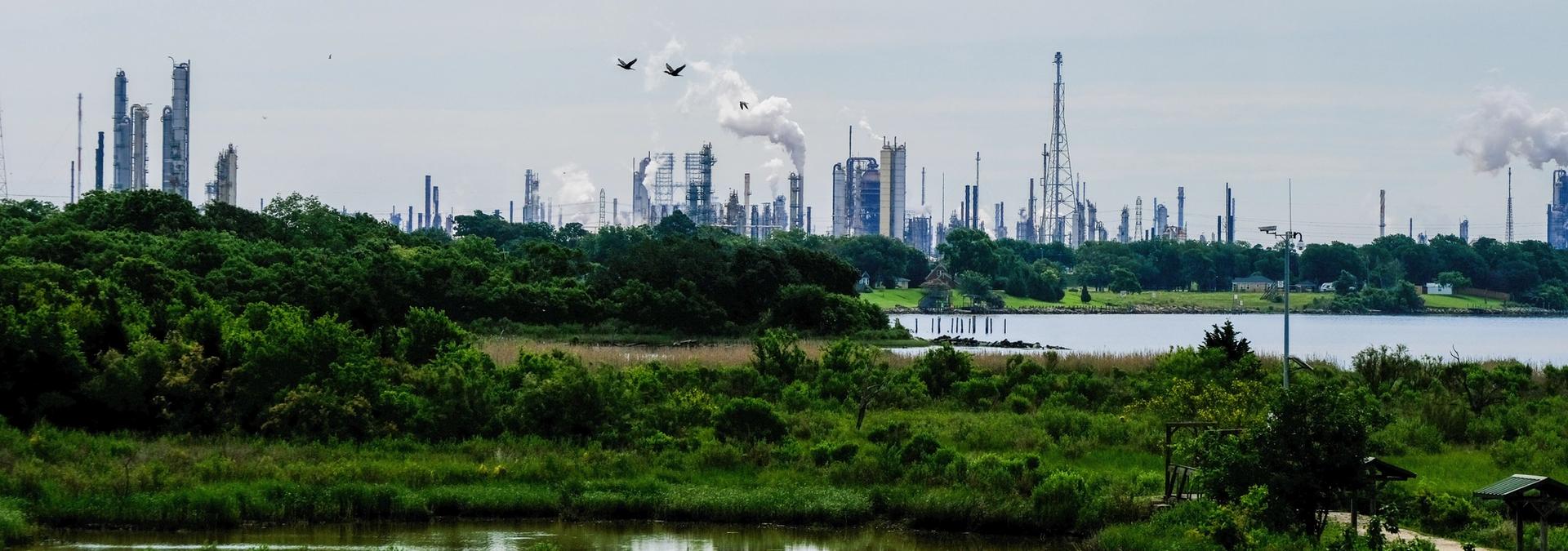
No amount of benzene is safe to breathe. The worst polluters of it operate in Houston.
Some of the worst polluters of benzene in the U.S. are located in Texas, including ExxonMobil's Baytown refinery.
Most weekends, you’ll see Houstonians spending time outside, playing pick-up soccer and disc golf at Milby Park on Sims Bayou and swimming at Sylvan Beach Park in La Porte. You’ll see teenagers dressed to the nines for quinceañeras and dads with fishing poles resting on their shoulders.
But these outdoor activities take place in the shadows of the oil industry. Each day, near these same parks and beaches, Houston refineries process 2.6 million barrels of crude oil. It’s a business that's fueled the state’s growth for more than a century. But the region’s refineries, including the ones along the Ship Channel, from Deer Park to Texas City, are responsible for emitting a variety of hazardous pollutants hazardous variety of pollutants and cancer-causing chemicals that drift into nearby communities.
Among these, benzene might pose the greatest threat, and those who live closest to the sources are at the greatest risk. A gaseous compound that evaporates from gasoline and other oil products, benzene is known to cause a variety of health problems that include anemia, nervous system damage, suppression of immune systems and leukemia. Short-term exposure to benzene can cause headaches, dizziness, confusion, eye, skin and respiratory irritation. Severe short-term exposure can lead to unconsciousness, even death. Long-term benzene exposure increases the risk of cancer.
To better understand benzene emissions and exposures to communities, the Environmental Integrity Project (EIP) created an online map and data tool called Benzene Pollution at Petroleum Refinery Fencelines. The interactive map illustrates the locations of the refineries across the U.S. that are the worst benzene emitters, as measured by air monitors positioned along the fences surrounding the plants. The data comes from air monitoring reports that refineries have been required to submit to EPA since 2018 because of new federal regulations that require the monitoring and reporting.
Those EPA regulations were the result of a 2012 lawsuit that Air Alliance Houston, the Louisiana Bucket Brigade, EIP and other organizations filed against EPA, demanding better protections for local communities from toxic air pollution.
EIP’s new mapping tool compiles the results of all those fenceline monitoring reports and analyzes which refineries across the U.S. exceeded the benchmarks for long-term public health risk (3 micrograms per cubic meter, based on a California health standard). The map also shows which refineries had benzene levels so high they exceeded EPA’s regulatory “action level” (a net, adjusted average of 9 micrograms per cubic meter) that is supposed to require refineries to launch investigations and take action to reduce emissions.
Within a half hour of downtown Houston, along the Ship Channel, are six oil refineries, all of which had benzene levels detected at their fencelines that exceeded the long-term public health threat level (3 micrograms) in 2021.
- The LyondellBasell Houston Refinery had an average of 17 micrograms per cubic meter in 2021, which was more than five times the long-term health threat level. The plant also significantly exceeded EPA’s action level of 9 micrograms.
- The Pasadena Refinery had an average of 12 micrograms per cubic meter in 2021, which was four times the long-term health threat level and also above EPA’s regulatory action level.
- The Baytown Refinery on the Ship Channel had an average of almost 9 micrograms per cubic meter last year.
- The Deer Park Refinery east of Houston had an average of 8 micrograms last year.
- The Kinder Morgan Galena Park refinery had an average of 7.3 micrograms last year.
- The Valero Houston Refinery had an average of 3.3 micrograms last year.
"This new analysis shines a bright light on specific sources of a known carcinogen and provides important insight into why the Houston area is an industrial cancer hot spot,” says Jennifer Hadayia, the executive director of Air Alliance Houston.
A 2020 study published in the Journal of the National Cancer Institute concluded that people living within 10 miles of a Texas oil refinery were “statistically significantly more likely to be diagnosed with lymphoma” than people who lived 20 to 30 miles from a refinery.
Harmful benzene emissions are not unique to Texas. In 2021, almost half of U.S. oil refineries — 56 of 118 that submitted monitoring reports to EPA — reported average benzene concentrations at their fencelines that were high enough to be considered a long-term public health threat (above 3 micrograms per cubic meter.) Reducing these emissions will require a greater understanding of who is responsible for the pollution and how it impacts communities that are exposed. EIP’s data maps provide insight for anyone hoping to identify where benzene emissions are most prevalent.
“EPA and the oil refining industry really need to do more to crack down on these benzene emissions," says Eric Schaeffer, the executive director of EIP," because the fenceline concentrations at too many refineries are high enough to pose a potential threat to neighborhoods that are close by."
MacGillis-Falcon is a writer and researcher for the Environmental Integrity Project.
STAY UP TO DATE
The quality of our newsletter is considered satisfactory and poses little or no risk.
SUBSCRIBE

